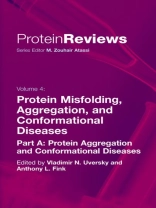This volume fills the gap in protein review and protocal literature while summarizing recent achievements in the understanding of the relationships between protein misfoldings, aggregation, and development of protein deposition disorders. It is devoted to the general questions of conformational disorders and includes discussion of involvement of such common factors as molecular chaperones, oxidative damage, proteasome, glycosoaminoglycans, serum amyloid protein P and several others in the development of different disorders. Some experimental techniques applicable for the visualization of protein deposition in vivo and in vitro are also present.
Table of Content
Structural and Conformational Prerequisites of Amyloidogenesis.- Structural and Conformational Prerequisites of Amyloidogenesis.- The Generic Nature of Protein Folding and Misfolding.- The Generic Nature of Protein Folding and Misfolding.- Relative Importance of Hydrophobicity, Net Charge, and Secondary Structure Propensities in Protein Aggregation.- Relative Importance of Hydrophobicity, Net Charge, and Secondary Structure Propensities in Protein Aggregation.- Cytotoxic Intermediates in the Fibrillation Pathway: A? Oligomers in Alzheimer’s Disease as a Case Study.- Cytotoxic Intermediates in the Fibrillation Pathway: A? Oligomers in Alzheimer’s Disease as a Case Study.- Glycosaminoglycans, Proteoglycans, and Conformational Disorders.- Glycosaminoglycans, Proteoglycans, and Conformational Disorders.- Apolipoproteins in Different Amyloidoses.- Apolipoproteins in Different Amyloidoses.- Oxidative Stress and Protein Deposition Diseases.- Oxidative Stress and Protein Deposition Diseases.- Chaperone and Conformational Disorders.- Chaperone Suppression of Aggregated Protein Toxicity.- Mechanisms of Active Solubilization of Stable Protein Aggregates by Molecular Chaperones.- The Aggresome: Proteasomes, Inclusion Bodies, and Protein Aggregation.- The Aggresome: Proteasomes, Inclusion Bodies, and Protein Aggregation.- Protein Aggregation, Ion Channel Formation, and Membrane Damage.- Protein Aggregation, Ion Channel Formation, and Membrane Damage.- Visualization of Protein Deposits In Vivo.- Congo Red Staining of Amyloid: Improvements and Practical Guide for a More Precise Diagnosis of Amyloid and the Different Amyloidoses.- Immunohistological Study of Experimental Murine AA Amyloidosis.- Visualization of Protein Deposits In Vitro.- Reporters of Amyloid Structure.-Three-Dimensional Structural Analysis of Amyloid Fibrils by Electron Microscopy.- Atomic Force Microscopy.- Direct Observation of Amyloid Fibril Growth Monitored by Total Internal Reflection Fluorescence Microscopy.- Animal and Cell Models of Human Neurodegenerative Disorders.- Drosophila and C. elegans Models of Human Age-Associated Neurodegenerative Diseases.- Genetically Engineered Mouse Models of Neurodegenerative Disorders.
Language English ● Format PDF ● Pages 419 ● ISBN 9780387259192 ● File size 7.9 MB ● Editor Vladimir N. Uversky & Anthony Fink ● Publisher Springer US ● City NY ● Country US ● Published 2007 ● Downloadable 24 months ● Currency EUR ● ID 2144212 ● Copy protection Social DRM












